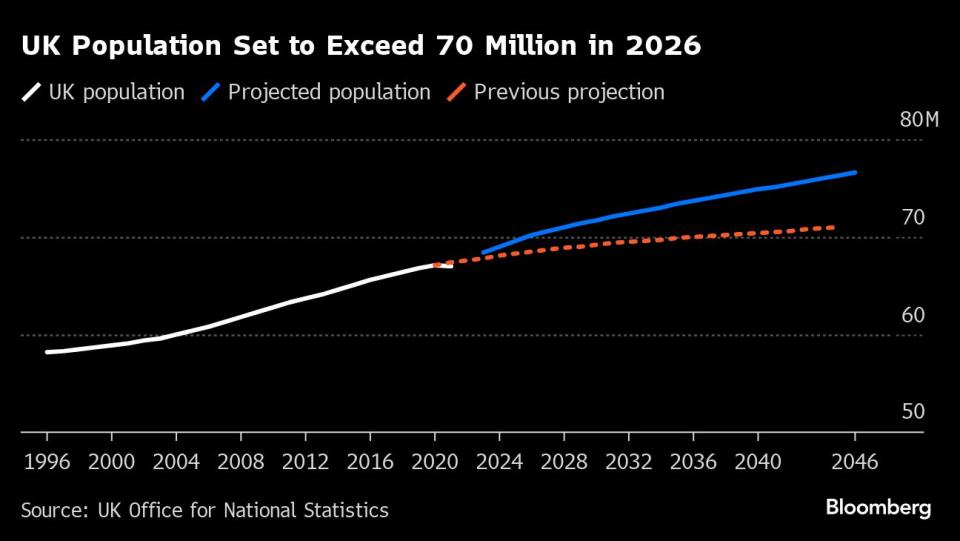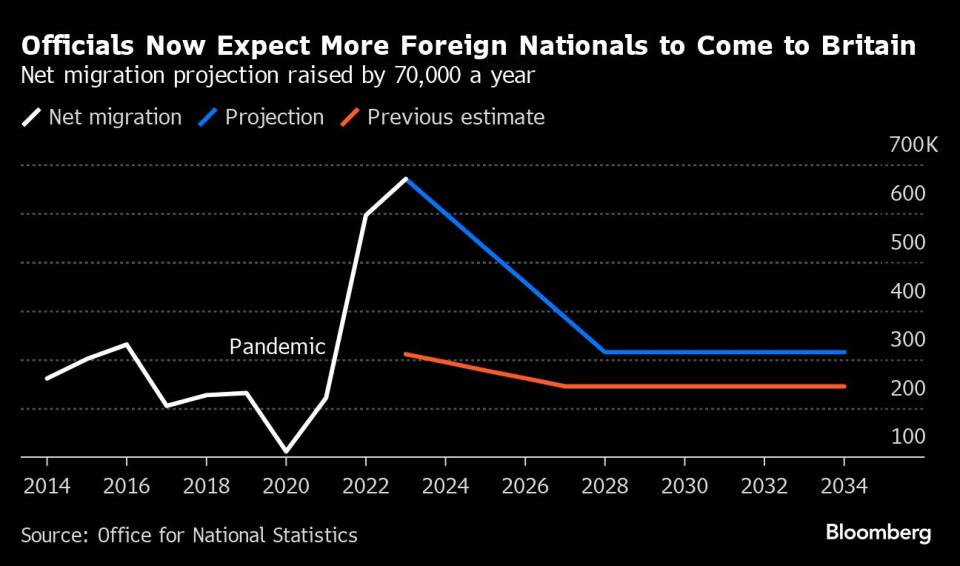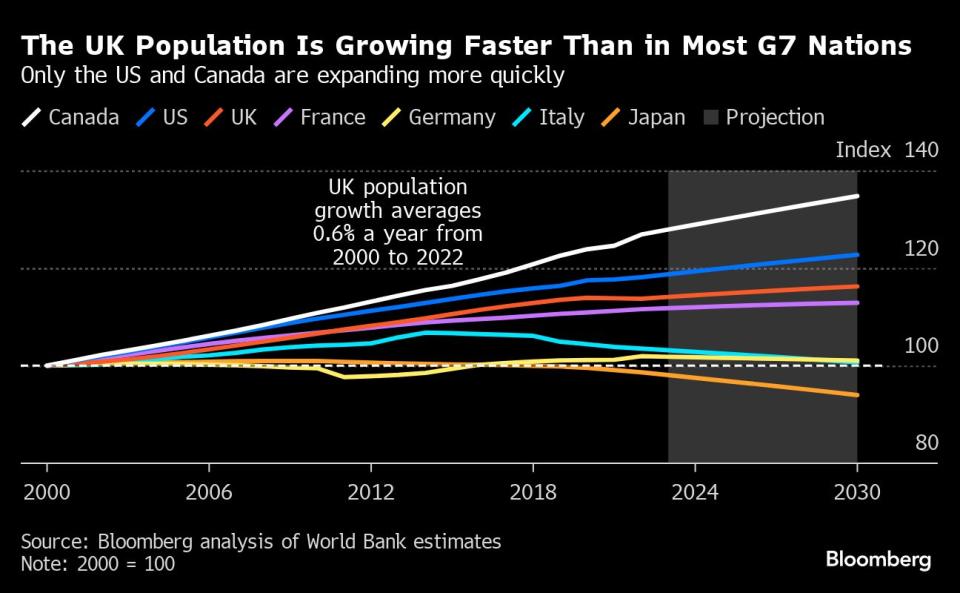UK Says Migration Likely to Drive Stronger Population Growth
(Bloomberg) -- The UK estimated its population will balloon by 9.9% in the next 15 years, a trend that will both help the economy and exacerbate a rift within Prime Minister Rishi Sunak’s ruling Conservative Party.
Most Read from Bloomberg
Musk’s $55 Billion Pay Package Voided, Threatening World’s Biggest Fortune
Microsoft Sales Top Estimates; Cloud Growth Disappoints Some
Tech Giants Slide in Late Trading After Earnings: Markets Wrap
UPS CEO Kicks Off Productivity Drive by Cutting 12,000 Managers
The Office for National Statistics projected the number of people in the UK will grow by 6.6 million between the middle of 2021 and 2036, almost all of which will come from immigration. Net migration is likely to average 315,000 a year from the middle of 2028.
While this would result in net migration more than halving from last year’s record, overall population growth is stronger than the ONS estimated a year ago. That’s likely to boost the capacity of the economy to grow over the coming years, which will help the Bank of England in its efforts to head off inflation and could bring in more revenue for the Treasury. Yet it cuts against Sunak’s promise to rein in migration.
“There is little doubt that migration will fall sharply from current levels over the next few years, and indeed it would not be surprising if the fall was steeper than ONS are projecting,” said Jonathan Portes, professor of economics at King’s College London. “However, in the short to medium term, these projections may slightly improve the outlook for growth and the fiscal position.”
The ONS estimates that the number of people in the UK will hit 70 million by mid-2026. It highlights a demographic advantage Britain has developed over most of its neighbors in Europe since the start of the century. While Germany, Italy and Japan are likely to see either no growth or populations shrink, the UK is expanding.
But the figures height concerns among Conservatives about migration which ministers say is straining public services, from schools to hospitals. Sunak is seeking to cut migration through controversial policies such as sending asylum seekers to Rwanda and limiting visas for dependents of overseas students.
Last year, net migration to the UK — or the number of people who arrived minus those who left — hit a record 745,000. While this now appears to be falling, the ONS estimate of long-term net migration would is still more than triple the 100,000 target that the Conservatives promised during the last general election in 2019.
“I’ve been clear that migration is too high and we must get back to sustainable levels,” Home Secretary James Cleverly said in a statement. “Last year I set out robust measures to reduce the numbers coming into our country – tightening the rules on care workers, skilled workers, and making sure that people can support their family members that they bring over.”
For the economy, the population figures suggest stronger growth is possible, which would help pull the UK out of stagnation that may well have turned to a recession at the end of last year. The Bank of England last year said the UK’s growth potential was limited by the availability of workers. Supply constraints fed inflation that prompted the sharpest series of interest rate hikes in decades.
Portes cautioned against reading too much into the figures. “They do not take account of recent migration policy changes,” he said, noting the Rwanda “deterrent” program and limitations on visas granted to workers and dependents.
But Torsten Bell, chief executive at think-tank the Resolution Foundation, said the figures would worsen the UK’s “fiscal fiction” on post-election spending. The government’s forecasts will “bank the tax revenues from a bigger population,” he said on social media site X, “but pretend (ridiculously) that it won’t require more public spending.”
Population growth in line with the ONS’s projections would mean bigger cuts to spending per person, he added, leading to a drop in the quality of public services.
While the final scale of the growth will depend on policy, the UK population is almost certainly going to age. The ONS thinks the proportion of people in the UK aged 85 years and over will increase from 2.5% to 3.5% by 2036.
Births will only just out-pace deaths over the whole 15-year period, by 541,000. By mid-2035, the ONS said, that trend would reverse — more people will be dying than being born, adding to pressure on the UK’s National Health Service.
Richard Hughes, chair of the UK’s Office for Budget Responsibility, explained in front of the House of Lords’ Economic Affairs Committee earlier this month the pressure which an aging population would place on the public purse.
In the near-term, a falling birth rate would reduce the cost of education, he said. “But that is not good news for demographics in the longer term, because it means fewer workers and taxpayers supporting growing numbers of people who are retired.”
Hughes added that there is “a window of opportunity over the next five to 10 years to take action in these areas to deal with the demographic challenges.”
--With assistance from Andrew Atkinson.
(Updates with details from the report and comment)
Most Read from Bloomberg Businessweek
There’s So Much Data Even Spies Are Struggling to Find Secrets
Basketball, Basketball, Basketball: Inside Steve Ballmer’s New $2 Billion Arena
Chinese Students Abroad Struggle With Tuition as Economy Falters
©2024 Bloomberg L.P.





